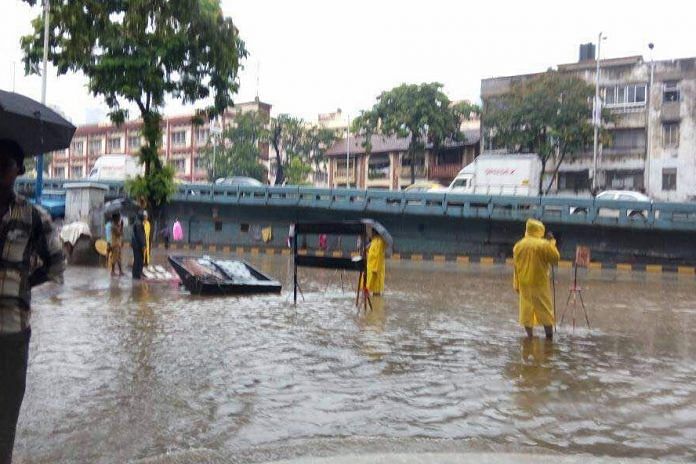Mumbai, the country’s financial capital, was brought to a halt on 29 August due to torrential rainfall. In a scenario reminiscent of the 2005 deluge, several Mumbaikars were left stranded for hours as transport systems collapsed. As of 31 August, 14 were dead, including two toddlers, and 12 were missing.
Analysts blame increased concretisation, variable rainfall patterns and unplanned, aggressive urbanisation. The city has spent crores on drainage, but seems to fail every time there are torrential rains.
Why is flooding in Mumbai an annual feature and what is the solution to it? We ask experts.
After the July 2005 floods, BMC installed five pumping stations in the city — Shailesh Fanse, ex-Corporator, Shiv Sena
 Geographical conditions and shape of Mumbai city is such that it is prone to repeated flooding. Since it is a harbour city, the nature of flooding is also dependant on high tides and low tides.
Geographical conditions and shape of Mumbai city is such that it is prone to repeated flooding. Since it is a harbour city, the nature of flooding is also dependant on high tides and low tides.
Other major cities in India like Delhi, Ahmedabad, and Chennai also face the problem of water-logging, but the media doesn’t scrutinize the local authorities in those cities as much. We all know what happened during Chennai floods, but all the outrage is reserved for Mumbai only.
Under Shiv Sena, we have done a lot in the BMC to tackle this problem. After the July 2005 floods, BMC installed five pumping stations in the city, which flush out 10,000 litres of water per minute. In fact, on Tuesday itself, BMC flushed out 10000 billion litres in just five hours.
BMC has also become more receptive to the problems of people over the years. This time everyone was out on the streets of Mumbai helping each other, which in itself is a considerable improvement compared to the past.
BMC has a disaster management cell but they have not published any disaster management plan — Madhav Bhandari, Chief Spokesperson, Maharashtra BJP
 It is mentioned in Portuguese and British records of the 17th century that a few islands of Mumbai had submerged due to heavy rain. Then British published a gazette in 1897, which records several parts of Mumbai submerging due to rain. It is a proven fact Mumbai is prone to flooding in rain.
It is mentioned in Portuguese and British records of the 17th century that a few islands of Mumbai had submerged due to heavy rain. Then British published a gazette in 1897, which records several parts of Mumbai submerging due to rain. It is a proven fact Mumbai is prone to flooding in rain.
After the July 2005 floods, the state government constituted a committee under Dr. Madhav Rao, which submitted its report in a record three months’ time, but none of its recommendations have been implemented in the last 12 years.
The committee recommended 26 pumping stations, as of today only five are working out of the six installed. It also suggested widening and deepening of nullahs (sewers) but the nullahs have disappeared.
There are no outlets for storm water. Where will the water go? Because of concretization, water does not seep inside and there is no channel for the overflowing water.
On the administrative front, the responsibility or the lack of it lies squarely with the previous Congress-led government and the Shiv Sena-ruled BMC, in which we were minor partner. Every year, the BMC is spending Rs. 1200 crore on nullah safai (cleaning sewers), but we saw what happened Tuesday. BMC has a disaster management cell but they have not published any disaster management plan.
We must stop our piecemeal planning process, or we will forever be an accidental city — P. K. Das, Architect & urban affairs activist

The central points are mindless urbanisation and excessive concretisation of the city. To top it all, this city is still being led into a model of expansion without planning. These are the three fundamental reasons because of which specific work on issues of infrastructure and services are not able to deliver.
You may have an excellent storm water drainage system but it cannot perform on its own if the other services are not at par or planned as an integrated system. We do our planning piecemeal, we do our budgeting piecemeal and this is because the politicians and bureaucrats don’t understand the urban planning process but they still want to control development.
They are, therefore, busy with preparing policies without any knowledge of the impact of policy on the built-form of the city. This causes anarchic growth. Mumbai’s growth story is a story of anarchy.
Every administration loves excessive concretisation in order to maximise turnover, and hence profit. We are observing that trees are falling not because of storms or cyclones or heavy rain, but because the roots have been severed because of concretisation. So what we have done in the process is we have led the city to an unsustainable ecological condition.
We must have a comprehensive planning of services, infrastructure and land use, without which a city can never have sustainable growth. It will forever be an accidental city.
#
Every resilient spirit in Mumbai deserves a resilient administration too — Milloni Doshi, Intern at A.T. Kearney, who was stranded in Mumbai

Yesterday seemed like any normal day working in our office when the receptionist abruptly burst in, informing us that they were evacuating everyone because of the incessant rain. As a Mumbaikar, this never causes immediate panic.
You groan because this means waterlogging, delayed trains and high surge pricing by Uber/Ola. But you are used to it because it’s an annual feature.
Yet, yesterday was reminiscent of a very scary day dating back to 2005 when the Maximum City came to a standstill. I compared statistics – 944mm of rain in 2005 and about 300mm yesterday; the city was jammed and flooded the same way back then.
With the amount of money the BMC has allegedly poured into rectifying this issue (over 12 years) one would expect the drainage systems to be in top condition, equipped to deal with torrential rain. However, the BMC immediately diverted blame to the high tides, which in their view, caused the flooding.
Even though the high tide compounded the situation, the BMC was responsible for the overflowing gutters and uncovered manholes that were clogged even before the high tide came in.
This recurring problem has two sources. Firstly, the de-silting of drains is carried out in a very haphazard manner by contractors with little accountability. They claim that they have filled 98 percent of potholes in the city. However, they are filled in a manner that barely lasts a few months. Secondly, the state only takes action after the fact. Despite warnings about the coming rain, no provisions were made to prepare and battle it.
Mumbaikars always overcome problems because of their “resilient spirit” and “generosity”, but every resilient spirit deserves a resilient state too.
curated and compiled by ThePrint journalists Talha Ashraf and Divya Narayanan



